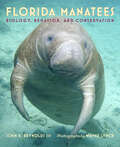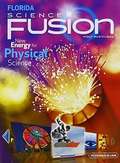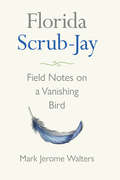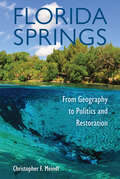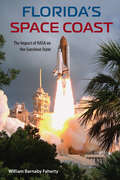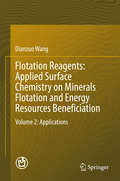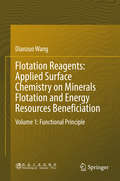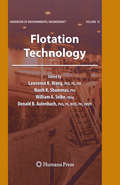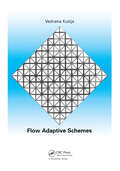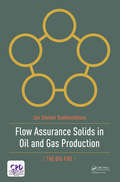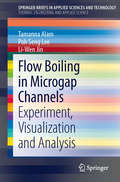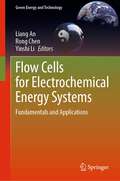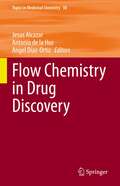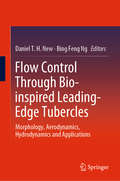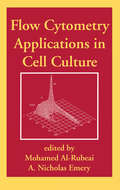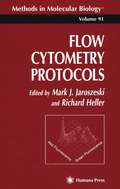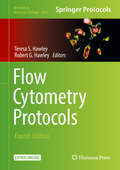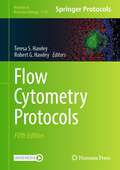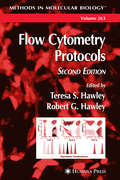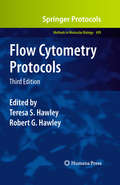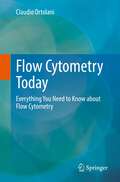- Table View
- List View
Florida Manatees: Biology, Behavior, and Conservation
by John E. Reynolds IIIA photographic guide that “focuses on the beauty, grace and vulnerability of these herbivores, but it also covers other sea mammals and their habitats” (The Biologist).Named a Choice Outstanding Academic TitleIn this book, manatee expert John E. Reynolds III and famed photographer Wayne Lynch join forces to reveal the clearest portrait of manatees ever published. Florida Manatees is a song for the manatee, a celebration of the lives of these majestic creatures. Reynolds’s concise, informative text shares what scientists know about manatees, while Lynch’s beautiful photographs instantly demonstrate how special these “potatoes with whiskers” really are. By encouraging an appreciation of manatees, the authors hope to help ensure a future in which Floridians can find ways to coexist with and continue to enjoy these uniquely wonderful sirenian inhabitants of their state.Included in this book:How manatees first came to Florida watersHow manatees fit into the ecosystems of FloridaWhat and how much manatees eatHow manatees behave and communicate with one anotherWhy manatees look the way they doWhy manatees have whiskersHow manatee mothers feed their young and much more“A lovely book that sounds as though it would appeal primarily to scientists, but which offers inviting color photos and history that make it accessible to lay audiences both within Florida and outside the state.” —Donovan’s Literary Services
Florida Physical Science
by Dinah Zike Marilyn Thompson Charles William McLaughlinNIMAC-sourced textbook
Florida Science Fusion: New Energy for Physical Science
by Marjorie Frank Michael R. Heithaus Michael A. DiSpezioNIMAC-sourced textbook
Florida Scrub-Jay: Field Notes on a Vanishing Bird
by Mark Jerome WaltersA portrait of a species on the brink The only bird species that lives exclusively in Florida, the Florida scrub-jay was once common across the peninsula. But as development over the last 100 years reduced the habitat on which the bird depends from 39 counties to three, the species became endangered. With a writer’s eye and an explorer’s spirit, Mark Walters travels the state to report on the natural history and current predicament of Florida’s flagship bird.Tracing the millions of years of evolution and migration that led to the development of songbirds and this unique species of jay, Walters describes the Florida bird’s long, graceful tail, its hues that blend from one to the next, and its notoriously friendly manner. He then focuses on the massive land-reclamation and canal-building projects of the twentieth century that ate away at the ancient oak scrub heartlands where the bird was abundant, reducing its population by 90 percent.Walters also investigates conservation efforts taking place today. On a series of field excursions, he introduces the people who are leading the charge to save the bird from extinction—those who gather for annual counts of the species in fragmented and overlooked areas of scrub; those who relocate populations of scrub-jays out of harm’s way; those who survey and purchase land to create wildlife refuges; and those who advocate for the prescribed fires that keep scrub ecosystems inhabitable for the species.A loving portrayal of a very special bird, Florida Scrub-Jay is also a thoughtful reflection on the ethical and emotional weight of protecting a species in an age of catastrophe. Now is the time to act, says Walters, or we will lose the scrub-jay forever.
Florida Springs: From Geography to Politics and Restoration
by Christopher F. MeindlFlorida Book Awards, Gold Medal for Florida NonfictionAmerican Association of Geographers Globe Book Award for Public Understanding of GeographyAn indispensable resource for learning about the freshwater wonders of Florida Florida is home to over 1,000 freshwater springs, natural wonders that have drawn people to enjoy and interact with them over the course of millennia. This book provides a clear and comprehensive overview of the geography, history, science, and politics of the springs, informing readers about the deep past and current issues facing these treasures of the Florida landscape. Christopher Meindl explains the unique physical features of Florida’s springs, including the “swiss cheese” structure of the state’s aquifers and the complexities of its groundwater hydrology, providing helpful maps, graphs, and photos. Meindl discusses how ancient and modern people have used the springs—as centers of communities, therapeutic spas, roadside attractions, parks, and more. He addresses contemporary threats to the springs in areas such as water flow, water quality, and overcrowding. Finally, he explores recent state policies, the activism of environmentalists, and current and potential restoration projects that seek to prevent springs degradation. Meindl brings to light a struggle for truth among scientists, politicians, and businesspeople about the causes of problems the springs face today. Challenging oversimplified answers and looking at multiple hypotheses, Meindl raises intriguing questions that will inspire readers to join the ongoing discussion about how best to protect and restore Florida’s iconic freshwater sanctuaries.
Florida's Space Coast: The Impact of NASA on the Sunshine State (Florida History and Culture)
by William B. Faherty"An important, interesting study of the relations between the Kennedy Space Center and the communities of Brevard County, Florida."--Roger D. Launius, chief historian, NASA, Washington, D.C."This outstanding book provides readers of Florida history our first insight into the impact that high technology has had on the state. Brevard County is a veritable laboratory for understanding what happens when space science and engineering put down roots in a wilderness setting. Faherty's writing is direct, simple, even folksy at times. I devoured it!"--Michael Gannon, author of Pearl Harbor Betrayed and A Short History of FloridaFlorida&’s Space Coast tells the compelling story of America's half century in space exploration, from the successful launch of the first two-stage rocket in 1950 through the latest space shuttle missions of 2000. Told from the unique viewpoint of the people who built the Spaceport, this book shows how the space program transformed the east central Florida coast from a traditional citrus production and tourist area to one of the most influential high-tech centers in the nation.Cape Canaveral was chosen as a missile launch site because of its many geographical advantages. However, in the early years of the space program, the area was far from an ideal place for NASA employees to raise their families. NASA brought in thousands of space-related workers, who, besides sending machines and men into space, had to meet the challenge of moving their families from urban environs to a rural southern county. This book engagingly recounts the parallel stories of the establishment of America's space program and its impact on the development of Brevard County.William Barnaby Faherty is professor emeritus of history at St. Louis University and director of the Museum of the Western Jesuit Missions in Hazelwood, Missouri.
Flotation Reagents: Applied Surface Chemistry on Minerals Flotation and Energy Resources Beneficiation
by Dianzuo WangThis volume presents essential information on chemical reagents commonly used in flotation processes. It comprehensively summarizes the properties, preparation and applications of collectors, frothers, depressants and flocculants. It also discusses the microanalysis of flotation reagents and adsorption measurement. The book offers a valuable resource for all university researchers and students, as wells as R&D engineers in minerals processing and extractive metallurgy who wish to explore innovative reagents and technologies that lead to more energy efficient and environmentally sustainable solutions.
Flotation Reagents: Applied Surface Chemistry on Minerals Flotation and Energy Resources Beneficiation
by Dianzuo WangThis book summarizes the author's findings on the functional principle of flotation reagents, gathered over the past few decades. The fundamentals of and approaches common to surface chemistry are applied to study the reagents' structure and performance, as well as their interaction with minerals. In particular, the book establishes the theoretical criteria for collector performance. It also includes the quantum chemistry parameters, steric configuration, HOMO and LUMO surface of various reagents. The book offers a valuable resource for all university graduate students, researchers and R&D engineers in minerals processing and extractive metallurgy who wish to explore innovative reagents and technologies that lead to more energy efficient and environmentally sustainable solutions.
Flotation Technology
by Lawrence K. Wang Nazih K. Shammas Donald B. Aulenbach William A. SelkeThe Handbook of Environmental Engineering series is an incredible collection of methodologies that study the effects of pollution and waste in their three basic forms: gas, solid, and liquid. This exciting new addition to the series, Volume 12: Flotation Technology, has been designed to serve as both a basic flotation textbook and a comprehensive reference book. An indispensable guide for advanced undergraduate and graduate students, designers of water and wastewater treatment systems, scientists, and researchers, this volume is essential for all readers who are interested in the specialized investigation of the theory and practice of various wastewater systems. A critical volume in the Handbook of Environmental Engineering series, chapters employ methods of practical design and calculation illustrated by numerical examples, include pertinent cost data whenever possible, and explore in great detail the fundamental principles of the field. Volume 12: Flotation Technology, provides information on some of the most innovative and ground-breaking advances in the field today from a panel of esteemed experts. Coverage of the principles of air flotation technology and the fundamentals of water and wastewater flotation and lake restoration. Emphasis on industry standards, trends in the field, full-scale operation and laboratory simulation of air flotation processes. Examples of actual operating water and wastewater treatment plants based on air flotation Reference of practical use to scientists, researchers, educators and designers of water and wastewater treatment systems. Contents: Principles of Air Flotation Technology. Gas Dissolution, Release, and Bubble Formation. Separation of Oil From Wastewater. Fundamentals of Wastewater Flotation. Electroflotation. Electrocoagulation-flotation. Treatment of Paper Mill Whitewater. Recycling and Recovery of Raw Materials. Ozone-oxygen Oxidation Flotation, Wastewater Renovation by Flotation. Flotation-Filtration System for Wastewater Reuse. Algae Removal by Flotation. Completely Closed Water Systems in Paper Mills. Lake Restoration Using DAF. Jiminy Peak, Hancock, Massachusetts Wastewater Treatment Plant. Pittsfield, Massachusetts Water Treatment System. Pretreatment of Meat Processing Waste. Treatment of Seafood Processing Wastewater. Laboratory Simulation of Air Flotation Processes. Appendix. Index.
Flow Adaptive Schemes
by Vendrana KutijaA study in the development of flow adaptive numerical schemes in computational hydraulics directed to enhancing modelling capabilities. Examples covered include additional flow resistance due to flexible vegetation; one-dimensional supercritical flow; and flow in networks of channels.
Flow Assurance Solids in Oil and Gas Production: Fundamentals of Solids In Oil and Gas Production
by Jon GudmundssonThe precipitation and deposition of solids are a major challenge in the production of oil and gas. Flow assurance solids are formed because of unavoidable changes in temperature, pressure and composition of the oil-gas-water flowstream, from reservoir conditions to processing conditions. The advent of subsea production and the increased exploitation of heavy crudes have made flow assurance issues dominant in ensuring efficient and safe exploitation of hydrocarbon assets. Five troublesome flow assurance solids are described in the book: asphaltene, paraffin wax, natural gas hydrate, naphthenate and inorganic scale. These big-five solids are presented in stand-alone chapters. Each chapter is designed to be readable without clutter. Derivations of equations and descriptions of supporting details are given in several appendices. The book is intended for professional engineers and natural scientist working in E&P companies, engineering companies, service companies and specialized companies. An understanding of the big-five solids is required throughout the lifetime of oil and gas assets, from early development to abandonment. The technical, safety and environmental risks associated with deposition problems in near-wellbore formations, production tubing, wellhead equipment, flowlines and processing facilities, are relevant for decisions in the oil and gas industry and in outside regulatory and financial entities.
Flow Boiling in Microgap Channels: Experiment, Visualization and Analysis
by Poh Seng Lee Liwen Jin Tamanna AlamFlow Boiling in Microgap Channels: Experiment, Visualization and Analysis presents an up-to-date summary of the details of the confined to unconfined flow boiling transition criteria, flow boiling heat transfer and pressure drop characteristics, instability characteristics, two phase flow pattern and flow regime map and the parametric study of microgap dimension. Advantages of flow boiling in microgaps over microchannels are also highlighted. The objective of this Brief is to obtain a better fundamental understanding of the flow boiling processes, compare the performance between microgap and conventional microchannel heat sinks, and evaluate the microgap heat sink for instabilities and hotspot mitigation.
Flow Boiling of a Dilute Emulsion In Smooth and Rough Microgaps (Mechanical Engineering Series)
by Brandon M. Shadakofsky Francis A KulackiThis book elucidates heat transfer behavior for boiling of dilute emulsions- mixtures of two immiscible fluids- which has received little attention to date. Of the work completed in this area, the majority has been focused on pool boiling where no mean flow is present, and this book is the first major work to be published regarding flow boiling of emulsions. The book includes a comprehensive review and assessment of research on emulsion-based heat transfer. Recent experiments are reported and analyzed to characterize heat transfer in microgap flow boiling via a systematic investigation into the effects of gap size, mass flux, and volume fraction on the heat transfer coefficient and pressure drop. The emulsion used in all experiments comprises droplets of an immiscible electronics cooling fluid suspended in water. The volume provides a complete baseline for flow boiling of water in the microgaps, enabling a determination of the enhancement of the heat transfer coefficient when the disperse component is present. Moreover, a subset of the data set pertains to flow boiling of dilute emulsions over microporous surfaces. The flow conditions for which the microporous surfaces enhance or degrade heat transfer are presented. Finally, this book provides a discussion of the physical phenomena which affect boiling and a set of nondimensional numbers that can be used for correlation.
Flow Cells for Electrochemical Energy Systems: Fundamentals and Applications (Green Energy and Technology)
by Liang An Rong Chen Yinshi LiThis book is a state-of-the-art review on recent advances in flow cells for electrochemical energy systems. The book includes an introduction to flow cells, proton exchange membrane fuel cells, photocatalytic fuel cells, organic flow batteries, redox flow batteries, microfluidic flow cells, as well as electrolysis cells for CO2 and nitrogen reduction. The book provides an essential reference for professors, researchers, and policymakers globally in academia, industry, and government.
Flow Chemistry for the Synthesis of Heterocycles (Topics in Heterocyclic Chemistry #56)
by Upendra K. Sharma Erik V. Van der EyckenThis volume provides an overview of recent developments and scope in the use of flow chemistry in relevance to heterocyclic synthesis. The heterocyclic ring is the most prominent structural motif in the vast majority of natural products as well as pharmaceutical compounds since this facilitates tuneable interactions with the biological target besides conferring a degree of structural and metabolic stability. In recent times, flow chemistry has heralded a paradigm shift in organic synthesis as it offers several unique advantages over conventional methods like drastic acceleration of sluggish transformations, enhanced yields, cleaner reactions etc and is gradually gaining a lot of attention among organic chemist worldwide. Given the importance of heterocycles in natural products, medicinal chemistry and pharmaceuticals, this is a well warranted volume and complements the previous volume of Topics in Organometallic Chemistry ‘Organometallic Flow Chemistry’. This volume offers a versatile overview of the topic, besides discussing the recent progress in the flourishing area of flow chemistry in relevance to heterocyclic chemistry; it will also help researchers to better understand the chemistry behind these reactions. This in turn provides a platform for future innovations towards the designing of novel transformations under continuous flow. Thus, this volume will appeal to both the novices in this field as well as to experts in academia and industry.
Flow Chemistry in Drug Discovery (Topics in Medicinal Chemistry #38)
by Antonio de la Hoz Jesus Alcazar Angel Díaz-OrtizThis book reviews the challenges and opportunities posed by flow chemistry in drug discovery, and offers a handy reference tool for medicinal chemists interested in the synthesis of biologically active compounds. Prepared by expert contributors, the respective chapters cover not only fundamental methodologies and reactions, such as the application of catalysis, especially biocatalysis and organocatalysis; and non-conventional activation techniques, from photochemistry to electrochemistry; but also the development of new process windows, processes and reactions in drug synthesis. Particular attention is given to automatization and library synthesis, which are of great importance in the pharmaceutical industry. Readers will also find coverage on selected topics of general interest, such as how flow chemistry is contributing to drug discovery R&D in developing countries, and the green character of this enabling technology, for example in the production of raw materials for the pharmaceutical industry from waste. Given its scope, the book appeals to medicinal chemistry researchers working in academia and industry alike, as well as professionals involved in scale-up and drug development.
Flow Control Through Bio-inspired Leading-Edge Tubercles: Morphology, Aerodynamics, Hydrodynamics and Applications
by Daniel T. H. New Bing Feng NgThis book describes and explains the basis of bio-inspired, leading-edge tubercles based on humpback whale flippers as passive but effective flow control devices, as well as providing a comprehensive practical guide in their applications. It first discusses the morphology of the humpback whale flipper from a biological perspective, before presenting detailed experimental and numerical findings from past investigations by various experts on the benefits of leading-edge tubercles and their engineering implementations.Leading-edge tubercle designs and functions have attracted considerable interest from researchers in terms of understanding their role in the underwater agility of these whales, and to exploit their flow dynamics in the development of new and novel engineering solutions. Extensive research over the past recent years has demonstrated that the maneuverability of these whales is at least in part due to the leading-edge tubercles acting as passive flow control devices to delay stall and increase lift in the post-stall regime. In addition to the inherent benefits in terms of aerodynamics and hydrodynamics, investigations into leading-edge tubercles have also broadened into areas of noise attenuation, stability and industrial applications.This book touches upon these areas, with an emphasis upon the effects of lifting-surface types, flow regimes, tubercle geometries, lifting-surface stability and potential industrial applications, among others. As such, it features contributions from key experts in the fields of biology, physics and engineering who have conducted significant studies into understanding the various aspects of leading-edge tubercles. Given the broad coverage and in-depth analysis, this book will benefit academic researchers, practicing engineers and graduate students interested in tapping into such a unique but highly functional flow control strategy.
Flow Cytometry Applications in Cell Culture
by Mohamed Al-RubeaiThis work present practical, biotechnological applications of flow cytometry techniques for the study of animal, plant and microbial cells, explaining methodologies for sample preparation, staining and analysis. It discusses cell variability in cell culture processes and shows how the quantitative analysis of heterogeneous populations aids in the biotechnological exploitation of cells.
Flow Cytometry Protocols
by Richard Heller Mark J. JaroszeskiIn addition to providing chapters on the theoretical and practical aspects of flow cytometry, this book contains protocols used specifically for immediate use in the diagnostic and experimental measurements enabled by modern flow cytometric instrumentation. Research protocols cover cell cycle analysis and regulation, detection of rare cells, solid tumor DNA techniques, ploidy analysis and the application of flow cytometric methods for measurements of leukemias, necrosis, apoptosis, heat shock proteins, liver and bladder cancer, disease monitoring, and intracellular measurements. Hematologic and immunologic applications are also described by researchers with a particular expertise in their use. A special section is included for biotechnologists using flow cytometry in the study of protein secretion, the monitoring of fermentation processes, monitoring bioreactors, cell-cell electroporation, quantitation electrofusion, and electrochemotherapy.
Flow Cytometry Protocols
by Robert G. Hawley Teresa S. HawleyFlow cytometry has evolved since the 1940s into a multidisciplinary field incorporating aspects of laser technology, fluid dynamics, electronics, optics, computer science, physics, chemistry, biology, and mathematics. Innovations in instrumentation, development of small lasers, discovery of new fluorochromes/fluorescent proteins, and implementation of novel methodologies have all contributed to the recent rapid expansion of flow cytometry applications. In this thoroughly revised and updated second edition of Flow Cytometry Protocols, time-proven as well as cutting-edge methods are clearly and comprehensively presented by leading experimentalists. In addition to being a valuable reference manual for experienced flow cytometrists, the editors expect this authoritative up-to-date collection to prove useful to investigators in all areas of the biological and biomedical sciences who are new to the subject. The introductory chapter provides an eloquent synopsis of the principles and diverse uses of flow cytometry, beginning with a historical perspective and ending with a view to the future. Chapters 2-22 contain step-by-step protocols of highly practical and state-of-the-art techniques. Detailed instructions and helpful tips on experimental design, as well as selection of reagents and data analysis tools, will allow researchers to readily carry out flow cytometric investigations ranging from traditional phenotypic characterizations to emerging genomics and proteomics applications. Complementing these instructive protocols is a chapter that provides a preview of the next generation of solid-state lasers, and one that describes a rapid means to validate containment of infectious aerosols generated during high-speed sorting (Chapters 23-24).
Flow Cytometry Protocols (Methods in Molecular Biology #2779)
by Robert G. Hawley Teresa S. HawleyThis fifth edition volume expands on the previous editions by presenting readers with the latest developments and emerging methodologies in cytometry. The chapters in this book cover cytometry basics such as lasers for cytometry, metrics that can be used to evaluate spillover spreading, and the process of panel design and iterative optimization for spectral flow cytometry; novel methodologies such as image-enabled cell sorting, co-staining of fluorochrome-conjugated and oligonucleotide-conjugated antibodies, and screening for cell type selective probes; and a look at the achievements made in the clinical setting for both flow and mass cytometry. Written in the highly successful Methods in Molecular Biology series format, chapters include introductions to their respective topics, lists of the necessary materials and reagents, readily reproducible step-by-step laboratory protocols, and tips on troubleshooting and avoiding known pitfalls.Cutting-edge and comprehensive, Flow Cytometry Protocols, Fifth Edition is a valuable resource for researchers and scientists who are interested in continuing or expanding their knowledge of this developing field.
Flow Cytometry Protocols, 2nd Edition
by Robert G. Hawley Teresa S. HawleyThis thoroughly revised and updated edition of a widely used practical guide to flow cytometry describes in step-by-step detail an array of time proven and cutting-edge techniques much needed in today's advanced laboratories. These readily reproducible methods deploy emerging flow cytometry technologies in many new applications, especially in the field of stem cells, functional genomics and proteomics, and microbiology. Here, the aspiring investigator will find methods for the characterization of stem/progenitor cells by monitoring the efflux of fluorescent dyes and the elucidation of signal transduction pathways using phospho-specific antibodies. There are also techniques for monitoring gene transfer and expression using fluorescent protein technology, high throughput screening for discovery of novel protein interactions, phenotypic and functional characterization of T cell subsets and precursors, and microbial flow cytometry, to highlight but some of the many useful procedures.
Flow Cytometry Protocols, 3rd Edition
by Robert G. Hawley Teresa S. HawleyWith rapid improvements in instrumentation, lasers, fluorophores, and data analysis software, flow cytometry is riding the crest of unprecedented, innovative advances. This thoroughly revised and up-to-date third edition of Flow Cytometry Protocols highlights the expanding contribution of flow cytometry to basic biological research and diagnostic medicine. Written by leading experts in the field, the book presents cutting-edge topics such as polychromatic, quantitative, and high throughput flow cytometry, novel multiparametric data analysis which breaks the dimensionality barrier, standard practice and safety measures for aerosol-generating cell sorting, conventional and imaging flow cytometry as well as minimalist imaging cytometry. As a volume in the highly successful Methods in Molecular Biology™ series, chapters contain brief introductions to their respective topics, lists of the necessary materials and reagents, step-by-step, readily reproducible laboratory protocols, and extensive notes on troubleshooting and avoiding known pitfalls. Authoritative and comprehensive, Flow Cytometry Protocols, Third Edition presents established as well as new flow cytometric methodologies in order to introduce beginning users to basic applications while opening new avenues of innovation for seasoned users.
Flow Cytometry Today: Everything You Need to Know about Flow Cytometry
by Claudio OrtolaniThis book covers all the technical aspects of flow cytometry needed to set-up the instrument, solve problems encountered in daily work, or necessary for exam preparation. It provides the reader with an in-depth look at the device and its applications. Each component and its function is described in an easy-to-understand manner, giving the reader a sound basic knowledge of this instrument. The practical examples given, simplify and enhance the learning process. This book is a unique resource of knowledge for biomedical engineers and biotechnologists, flow cytometry operators, laboratory technicians and biomedical researchers, both biologists as well as medical doctors, and can also be a helpful tool for companies and manufacturers.
